Citroen BERLINGO MULTISPACE 2008.5 2.G Owner's Manual
Manufacturer: CITROEN, Model Year: 2008.5, Model line: BERLINGO MULTISPACE, Model: Citroen BERLINGO MULTISPACE 2008.5 2.GPages: 161, PDF Size: 3.17 MB
Page 101 of 161
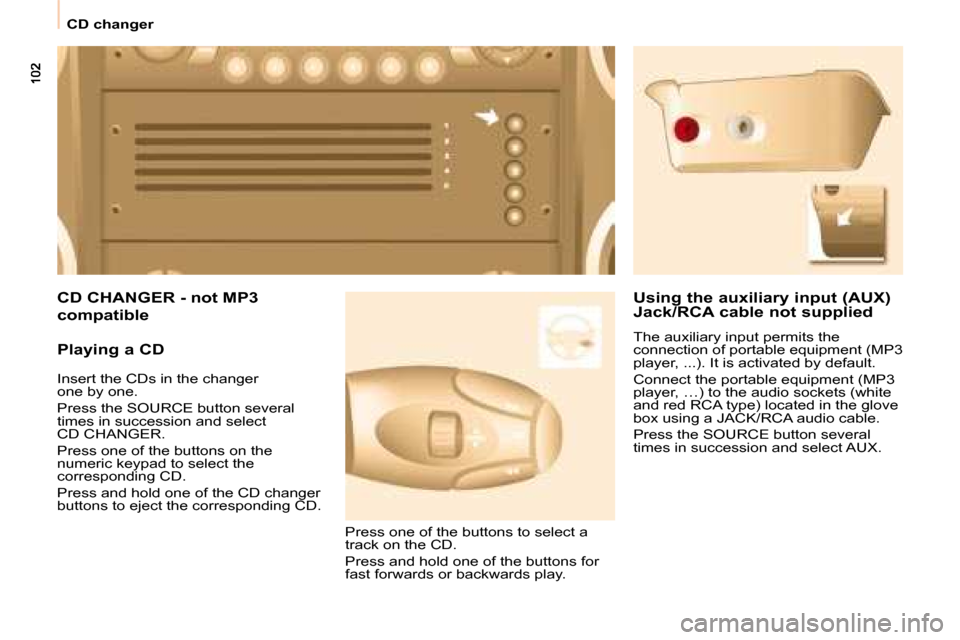
102102
CD changer
CD CHANGER - not MP3
compatible
Playing a CD Press one of the buttons to select a
track on the CD.
Press and hold one of the buttons for
fast forwards or backwards play.
Insert the CDs in the changer
one by one.
Press the SOURCE button several
times in succession and select
CD CHANGER.
Press one of the buttons on the
numeric keypad to select the
corresponding CD.
Press and hold one of the CD changer
buttons to eject the corresponding CD. Using the auxiliary input (AUX)
Jack/RCA cable not supplied
The auxiliary input permits the
connection of portable equipment (MP3
player, ...). It is activated by default.
Connect the portable equipment (MP3
player, …) to the audio sockets (white
and red RCA type) located in the glove
box using a JACK/RCA audio cable.
Press the SOURCE button several
times in succession and select AUX.
Page 102 of 161
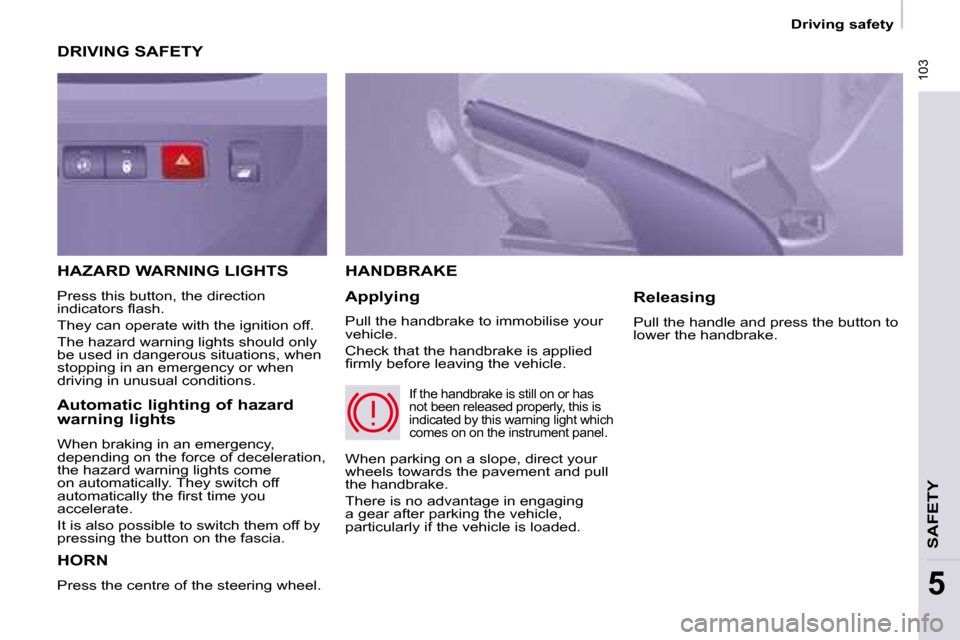
103
Driving safety
SAFETY
5
DRIVING SAFETY
HORN
Press the centre of the steering wheel.
HANDBRAKE
Applying
Pull the handbrake to immobilise your
vehicle.
Check that the handbrake is applied
�fi� �r�m�l�y� �b�e�f�o�r�e� �l�e�a�v�i�n�g� �t�h�e� �v�e�h�i�c�l�e�.� Releasing
Pull the handle and press the button to
lower the handbrake.
HAZARD WARNING LIGHTS
Press this button, the direction
�i�n�d�i�c�a�t�o�r�s� �fl� �a�s�h�.�
They can operate with the ignition off.
The hazard warning lights should only
be used in dangerous situations, when
stopping in an emergency or when
driving in unusual conditions.
When parking on a slope, direct your
wheels towards the pavement and pull
the handbrake.
There is no advantage in engaging
a gear after parking the vehicle,
particularly if the vehicle is loaded.
If the handbrake is still on or has
not been released properly, this is
indicated by this warning light which
comes on on the instrument panel
.
Automatic lighting of hazard
warning lights
When braking in an emergency,
depending on the force of deceleration,
the hazard warning lights come
on automatically. They switch off
�a�u�t�o�m�a�t�i�c�a�l�l�y� �t�h�e� �fi� �r�s�t� �t�i�m�e� �y�o�u�
accelerate.
It is also possible to switch them off by
pressing the button on the fascia.
Page 103 of 161
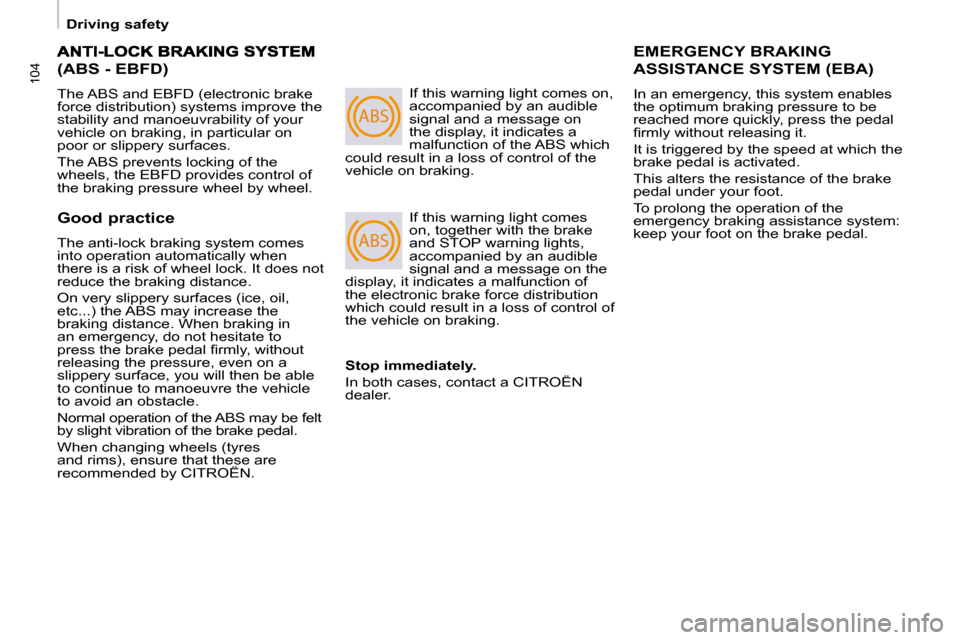
ABS
ABS
104
Driving safety
(ABS - EBFD)
The ABS and EBFD (electronic brake
force distribution) systems improve the
stability and manoeuvrability of your
vehicle on braking, in particular on
poor or slippery surfaces.
The ABS prevents locking of the
wheels, the EBFD provides control of
the braking pressure wheel by wheel. If this warning light comes on,
accompanied by an audible
signal and a message on
the display, it indicates a
malfunction of the ABS which
could result in a loss of control of the
vehicle on braking.
If this warning light comes
on, together with the brake
and STOP warning lights,
accompanied by an audible
signal and a message on the
display, it indicates a malfunction of
the electronic brake force distribution
which could result in a loss of control of
the vehicle on braking.
EMERGENCY BRAKING
ASSISTANCE SYSTEM (EBA)
In an emergency, this system enables
the optimum braking pressure to be
reached more quickly, press the pedal
�fi� �r�m�l�y� �w�i�t�h�o�u�t� �r�e�l�e�a�s�i�n�g� �i�t�.�
It is triggered by the speed at which the
brake pedal is activated.
This alters the resistance of the brake
pedal under your foot.
To prolong the operation of the
emergency braking assistance system:
keep your foot on the brake pedal.
Good practice
The anti-lock braking system comes
into operation automatically when
there is a risk of wheel lock. It does not
reduce the braking distance.
On very slippery surfaces (ice, oil,
etc...) the ABS may increase the
braking distance. When braking in
an emergency, do not hesitate to
�p�r�e�s�s� �t�h�e� �b�r�a�k�e� �p�e�d�a�l� �fi� �r�m�l�y�,� �w�i�t�h�o�u�t�
releasing the pressure, even on a
slippery surface, you will then be able
to continue to manoeuvre the vehicle
to avoid an obstacle.
Normal operation of the ABS may be felt
by slight vibration of the brake pedal.
When changing wheels (tyres
and rims), ensure that these are
recommended by CITROËN .
Stop immediately.
In both cases, contact a CITROËN
dealer.
Page 104 of 161
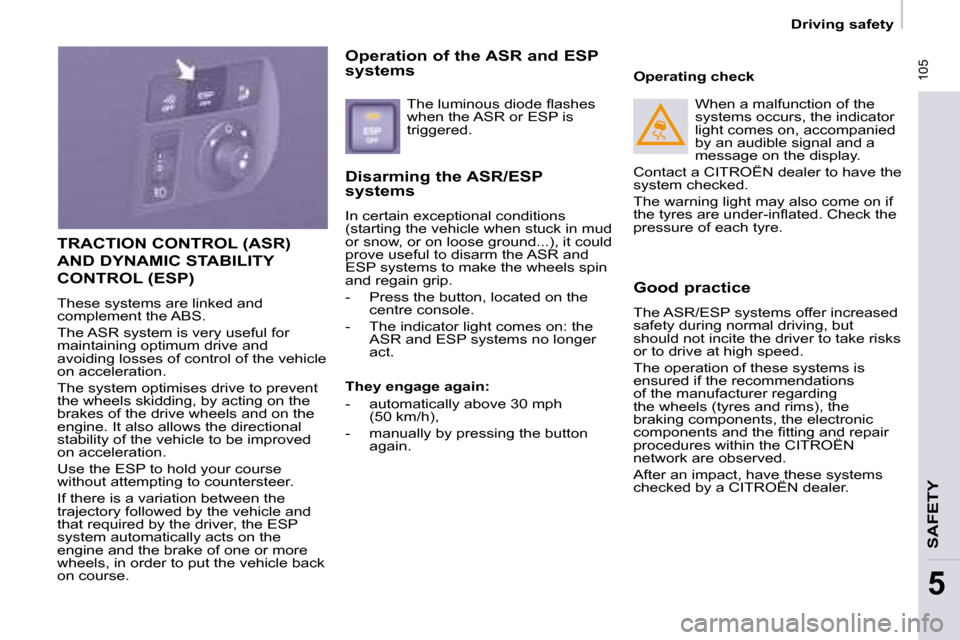
105
Driving safety
SAFETY
5
TRACTION CONTROL (ASR)
AND DYNAMIC STABILITY
CONTROL (ESP)
These systems are linked and
complement the ABS.
The ASR system is very useful for
maintaining optimum drive and
avoiding losses of control of the vehicle
on acceleration.
The system optimises drive to prevent
the wheels skidding, by acting on the
brakes of the drive wheels and on the
engine. It also allows the directional
stability of the vehicle to be improved
on acceleration.
Use the ESP to hold your course
without attempting to countersteer.
If there is a variation between the
trajectory followed by the vehicle and
that required by the driver, the ESP
system automatically acts on the
engine and the brake of one or more
wheels, in order to put the vehicle back
on course. Disarming the ASR/ESP
systems
In certain exceptional conditions
(starting the vehicle when stuck in mud
or snow, or on loose ground...), it could
prove useful to disarm the ASR and
ESP systems to make the wheels spin
and regain grip.
- Press the button, located on the
centre console.
- The indicator light comes on: the ASR and ESP systems no longer
act. Operating check
Good practice
The ASR/ESP systems offer increased
safety during normal driving, but
should not incite the driver to take risks
or to drive at high speed.
The operation of these systems is
ensured if the recommendations
of the manufacturer regarding
the wheels (tyres and rims), the
braking components, the electronic
�c�o�m�p�o�n�e�n�t�s� �a�n�d� �t�h�e� �fi� �t�t�i�n�g� �a�n�d� �r�e�p�a�i�r�
procedures within the CITROËN
network are observed.
After an impact, have these systems
checked by a CITROËN dealer.
Operation of the ASR and ESP
systems
� �T�h�e� �l�u�m�i�n�o�u�s� �d�i�o�d�e� �fl� �a�s�h�e�s�
when the ASR or ESP is
triggered.
They engage again:
- automatically above 30 mph (50 km/h),
- manually by pressing the button again. When a malfunction of the
systems occurs, the indicator
light comes on, accompanied
by an audible signal and a
message on the display.
Contact a CITROËN dealer to have the
system checked.
The warning light may also come on if
�t�h�e� �t�y�r�e�s� �a�r�e� �u�n�d�e�r�-�i�n�fl� �a�t�e�d�.� �C�h�e�c�k� �t�h�e�
pressure of each tyre.
Page 105 of 161

106106
Seat belts
SEAT BELTS
Height adjustment
Squeeze the control with the return and
slide the assembly on the driver’s seat
side and on the individual passenger
seat side.
Fastening
Pull the strap, then insert the tongue
into the buckle.
Check that the seat belt is fastened
correctly by pulling the strap. Driver’s seat belt not fastened
warning light � �T�h�e� �s�e�a�t� �b�e�l�t�s� �a�r�e� �fi� �t�t�e�d� �w�i�t�h� �a�n� �i�n�e�r�t�i�a�
reel which automatically adjusts the
length of the strap to your size. The
seat belt is rolled up automatically
when not in use.
Ensure that the seat belt is rolled up
correctly after use.
Depending on the nature and
seriousness of any impact, the
pretensioning device may be triggered
�b�e�f�o�r�e� �a�n�d� �i�n�d�e�p�e�n�d�e�n�t�l�y� �o�f� �i�n�fl� �a�t�i�o�n�
of the air bags. It instantly tightens
the seat belts against the body of the
occupants.
Triggering of the pretensioners is
accompanied by a slight discharge
of harmless smoke and a noise, due
to the activation of the pyrotechnic
cartridge incorporated in the system.
The force limiter reduces the pressure
of the seat belt against the body of the
�o�c�c�u�p�a�n�t�s�.� �T�h�e� �e�q�u�i�p�m�e�n�t� �fi� �t�t�e�d� �t�o�
these seat belts is operational when
the ignition is switched on.
� �T�h�e� �i�n�e�r�t�i�a� �r�e�e�l�s� �a�r�e� �fi� �t�t�e�d� �w�i�t�h� �a� �d�e�v�i�c�e�
which automatically locks the strap in
the event of a collision or emergency
braking. You can release the seat belt
and allow the strap to roll up.
The air bag warning light comes on
if the pretensioners are triggered.
Consult a CITROËN dealer.
Unfastening
Press the red button.
When the vehicle is started,
this warning light comes on if
the driver has not fastened his
seat belt.
Good practice
Wherever you are seated in the
vehicle, always fasten your seat belt,
even for short journeys.
Page 106 of 161
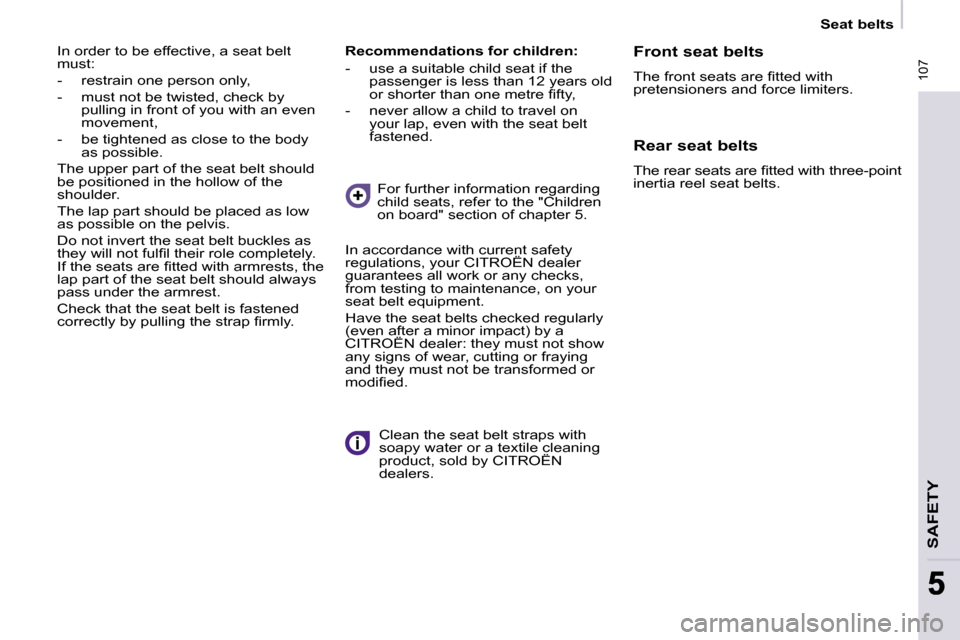
107
SAFETY
55
Seat belts
In order to be effective, a seat belt
must:
- restrain one person only,
- must not be twisted, check by pulling in front of you with an even
movement,
- be tightened as close to the body as possible.
The upper part of the seat belt should
be positioned in the hollow of the
shoulder.
The lap part should be placed as low
as possible on the pelvis.
Do not invert the seat belt buckles as
�t�h�e�y� �w�i�l�l� �n�o�t� �f�u�l�fi� �l� �t�h�e�i�r� �r�o�l�e� �c�o�m�p�l�e�t�e�l�y�.�
�I�f� �t�h�e� �s�e�a�t�s� �a�r�e� �fi� �t�t�e�d� �w�i�t�h� �a�r�m�r�e�s�t�s�,� �t�h�e�
lap part of the seat belt should always
pass under the armrest.
Check that the seat belt is fastened
�c�o�r�r�e�c�t�l�y� �b�y� �p�u�l�l�i�n�g� �t�h�e� �s�t�r�a�p� �fi� �r�m�l�y�.� Recommendations for children:
- use a suitable child seat if the
passenger is less than 12 years old
�o�r� �s�h�o�r�t�e�r� �t�h�a�n� �o�n�e� �m�e�t�r�e� �fi� �f�t�y�,�
- never allow a child to travel on your lap, even with the seat belt
fastened.
For further information regarding
child seats, refer to the "Children
on board" section of chapter 5.
Clean the seat belt straps with
soapy water or a textile cleaning
product, sold by CITROËN
dealers.
In accordance with current safety
regulations, your CITROËN dealer
guarantees all work or any checks,
from testing to maintenance, on your
seat belt equipment.
Have the seat belts checked regularly
(even after a minor impact) by a
CITROËN dealer: they must not show
any signs of wear, cutting or fraying
and they must not be transformed or
�m�o�d�i�fi� �e�d�.� Front seat belts
� �T�h�e� �f�r�o�n�t� �s�e�a�t�s� �a�r�e� �fi� �t�t�e�d� �w�i�t�h�
pretensioners and force limiters.
Rear seat belts
� �T�h�e� �r�e�a�r� �s�e�a�t�s� �a�r�e� �fi� �t�t�e�d� �w�i�t�h� �t�h�r�e�e�-�p�o�i�n�t�
inertia reel seat belts.
Page 107 of 161

108108
Air bags
AIR BAGS
The air bags have been designed to
maximise the safety of the occupants
in the event of a serious collision;
they work in conjunction with the force
limiting seat belts. In the event of a serious collision, the
electronic detectors record and analyse
the front and side impacts suffered in
the impact detection zones:
- in the event of a serious impact, the
�a�i�r� �b�a�g�s� �i�n�fl� �a�t�e� �i�n�s�t�a�n�t�l�y� �a�n�d� �p�r�o�t�e�c�t�
the occupants of the vehicle.
Immediately after the impact, the
�a�i�r� �b�a�g�s� �d�e�fl� �a�t�e� �r�a�p�i�d�l�y�,� �s�o� �t�h�a�t� �t�h�e�y�
do not hinder the visibility of the
occupants nor their possible exit
from the vehicle. - in the event of a minor or rear
impact and in certain roll-over
conditions, the air bags will not
be deployed; the seat belt alone
�i�s� �s�u�f�fi� �c�i�e�n�t� �t�o� �p�r�o�v�i�d�e� �m�a�x�i�m�u�m�
protection in these situations.
The seriousness of the collision
depends on the nature of the obstacle
and the speed of the vehicle at the
moment of impact.
Page 108 of 161
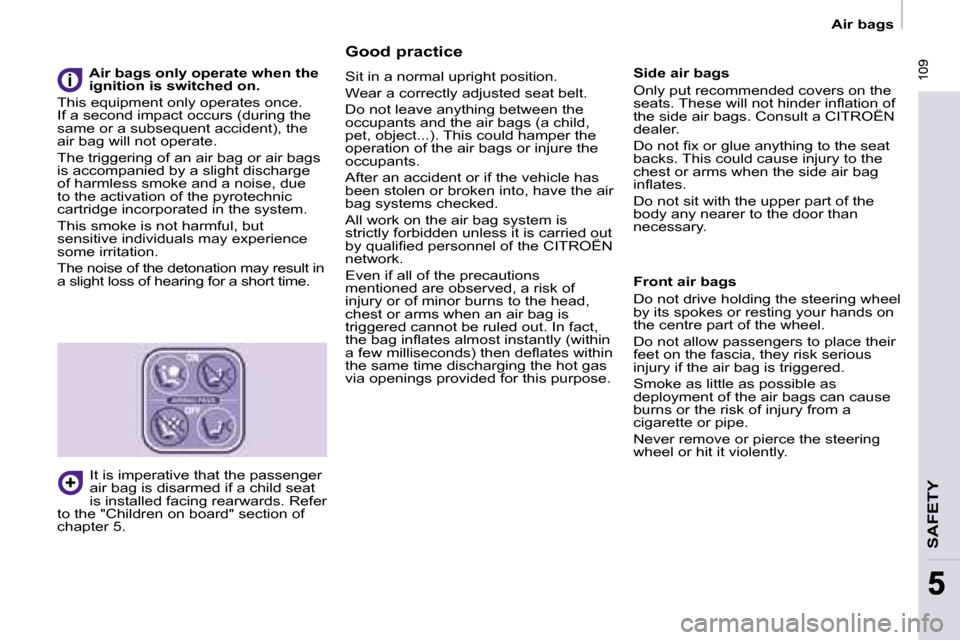
109
SAFETY
109
55
Air bags
Good practice
Sit in a normal upright position.
Wear a correctly adjusted seat belt.
Do not leave anything between the
occupants and the air bags (a child,
pet, object...). This could hamper the
operation of the air bags or injure the
occupants.
After an accident or if the vehicle has
been stolen or broken into, have the air
bag systems checked.
All work on the air bag system is
strictly forbidden unless it is carried out
�b�y� �q�u�a�l�i�fi� �e�d� �p�e�r�s�o�n�n�e�l� �o�f� �t�h�e� � �C�I�T�R�O��N� �
network.
Even if all of the precautions
mentioned are observed, a risk of
injury or of minor burns to the head,
chest or arms when an air bag is
triggered cannot be ruled out. In fact,
�t�h�e� �b�a�g� �i�n�fl� �a�t�e�s� �a�l�m�o�s�t� �i�n�s�t�a�n�t�l�y� �(�w�i�t�h�i�n�
�a� �f�e�w� �m�i�l�l�i�s�e�c�o�n�d�s�)� �t�h�e�n� �d�e�fl� �a�t�e�s� �w�i�t�h�i�n�
the same time discharging the hot gas
via openings provided for this purpose. Side air bags
Only put recommended covers on the
�s�e�a�t�s�.� �T�h�e�s�e� �w�i�l�l� �n�o�t� �h�i�n�d�e�r� �i�n�fl� �a�t�i�o�n� �o�f�
the side air bags. Consult a CITROËN
dealer.
� �D�o� �n�o�t� �fi� �x� �o�r� �g�l�u�e� �a�n�y�t�h�i�n�g� �t�o� �t�h�e� �s�e�a�t�
backs. This could cause injury to the
chest or arms when the side air bag
�i�n�fl� �a�t�e�s�.�
Do not sit with the upper part of the
body any nearer to the door than
necessary.
Front air bags
Do not drive holding the steering wheel
by its spokes or resting your hands on
the centre part of the wheel.
Do not allow passengers to place their
feet on the fascia, they risk serious
injury if the air bag is triggered.
Smoke as little as possible as
deployment of the air bags can cause
burns or the risk of injury from a
cigarette or pipe.
Never remove or pierce the steering
wheel or hit it violently.
Air bags only operate when the
ignition is switched on.
This equipment only operates once.
If a second impact occurs (during the
same or a subsequent accident), the
air bag will not operate.
The triggering of an air bag or air bags
is accompanied by a slight discharge
of harmless smoke and a noise, due
to the activation of the pyrotechnic
cartridge incorporated in the system.
This smoke is not harmful, but
sensitive individuals may experience
some irritation.
The noise of the detonation may result in
a slight loss of hearing for a short time.
It is imperative that the passenger
air bag is disarmed if a child seat
is installed facing rearwards. Refer
to the "Children on board" section of
chapter 5.
Page 109 of 161
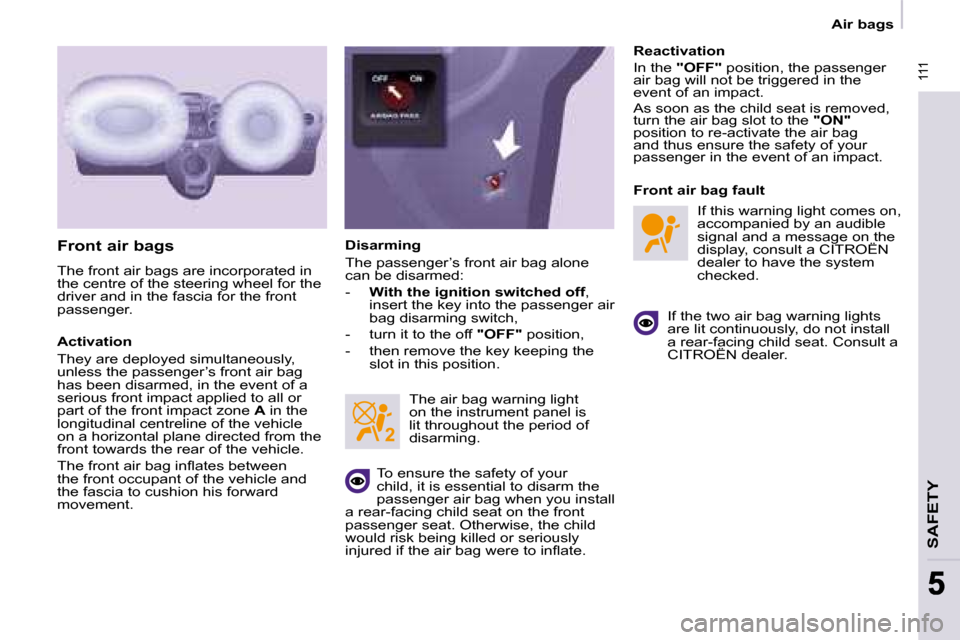
111
SAFETY
111
55
Air bags
Front air bags
The front air bags are incorporated in
the centre of the steering wheel for the
driver and in the fascia for the front
passenger.
Activation
They are deployed simultaneously,
unless the passenger’s front air bag
has been disarmed, in the event of a
serious front impact applied to all or
part of the front impact zone A in the
longitudinal centreline of the vehicle
on a horizontal plane directed from the
front towards the rear of the vehicle.
� �T�h�e� �f�r�o�n�t� �a�i�r� �b�a�g� �i�n�fl� �a�t�e�s� �b�e�t�w�e�e�n�
the front occupant of the vehicle and
the fascia to cushion his forward
movement. Disarming
The passenger’s front air bag alone
can be disarmed:
-
With the ignition switched off ,
insert the key into the passenger air
bag disarming switch,
- turn it to the off "OFF" position,
- then remove the key keeping the slot in this position.
The air bag warning light
on the instrument panel is
lit throughout the period of
disarming. If the two air bag warning lights
are lit continuously, do not install
a rear-facing child seat. Consult a
CITROËN dealer.
Front air bag fault
To ensure the safety of your
child, it is essential to disarm the
passenger air bag when you install
a rear-facing child seat on the front
passenger seat. Otherwise, the child
would risk being killed or seriously
�i�n�j�u�r�e�d� �i�f� �t�h�e� �a�i�r� �b�a�g� �w�e�r�e� �t�o� �i�n�fl� �a�t�e�.� � Reactivation
In the
"OFF" position, the passenger
air bag will not be triggered in the
event of an impact.
As soon as the child seat is removed,
turn the air bag slot to the "ON"
position to re-activate the air bag
and thus ensure the safety of your
passenger in the event of an impact.
If this warning light comes on,
accompanied by an audible
signal and a message on the
display, consult a CITROËN
dealer to have the system
checked.
Page 110 of 161

108108
Air bags
AIR BAGS
The air bags have been designed to
maximise the safety of the occupants
in the event of a serious collision;
they work in conjunction with the force
limiting seat belts. In the event of a serious collision, the
electronic detectors record and analyse
the front and side impacts suffered in
the impact detection zones:
- in the event of a serious impact, the
�a�i�r� �b�a�g�s� �i�n�fl� �a�t�e� �i�n�s�t�a�n�t�l�y� �a�n�d� �p�r�o�t�e�c�t�
the occupants of the vehicle.
Immediately after the impact, the
�a�i�r� �b�a�g�s� �d�e�fl� �a�t�e� �r�a�p�i�d�l�y�,� �s�o� �t�h�a�t� �t�h�e�y�
do not hinder the visibility of the
occupants nor their possible exit
from the vehicle. - in the event of a minor or rear
impact and in certain roll-over
conditions, the air bags will not
be deployed; the seat belt alone
�i�s� �s�u�f�fi� �c�i�e�n�t� �t�o� �p�r�o�v�i�d�e� �m�a�x�i�m�u�m�
protection in these situations.
The seriousness of the collision
depends on the nature of the obstacle
and the speed of the vehicle at the
moment of impact.